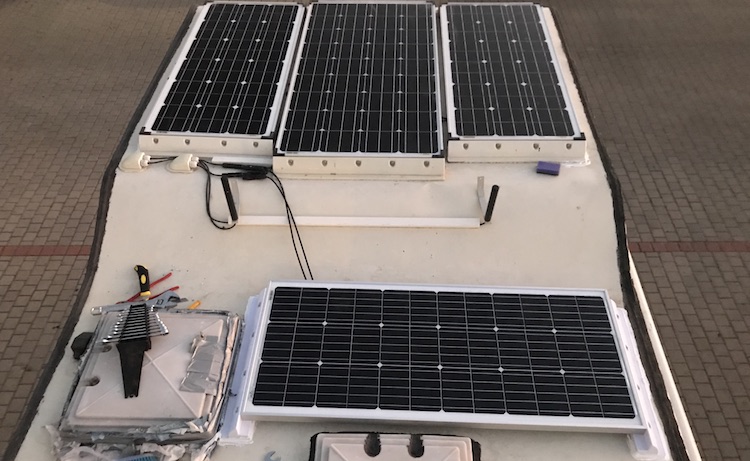On a sunny day in the summer, I was able to collect up to 2,300Wh with my 350Wp solar system. That was more than I needed to cover my daily energy consumption. Since June, the number of sunshine hours had decreased each day. On a sunny day in October, I ended up collecting about 1,200Wh. That was still more than enough to operate my mobile office that required about 360Wh a day. But I had to turn off the fridge more often. Not a big deal as the temperatures slightly decreased, too. Nevertheless, I wanted to improve my setup a little bit.
Using the full capacity of the charge controller
My solar charge controller can handle up to 440W. So I ordered another 100Wp solar panel (540mm x 1200mm), matching spoilers and SikaFlex 252 adhesive. Two weeks later, I finally mounted the panel on the roof during a nice sunset in a parking lot in Madrid.

Limited space and the slope of the alcove forced me to screw the panel onto the spoilers with a slight offset. Nevertheless, a solid construction with a total capacity of 450Wp:

The new panel increased the average yield from 1,200Wh up to 1,600Wh.
Reducing the power consumption of my office
So far, I had used the default MagSafe 2 power adapter to charge my laptop. The power adapter converted 230V DC down to 20V AC. I had to plug the adapter into my voltage converter that converted the battery’s 12V AC to 230 DC. A lot of conversions with an undesired byproduct: heat. A single adapter that converts 12V AC to 20V AC seemed way more efficient. So I installed a panel with two 12V sockets and an additional USB outlet into one of the seat benches in the back of my van. Finally I could skip the AC-to-DC-to-AC conversion by charging my laptop with a third-party 12V MagSafe 2 charger that was directly connected to the battery.

With the new setup I save more than 12W that correspond roughly to 100Wh a day. Not too bad: The yield of my solar system increased by 400Wh while my energy consumption decreased by 100Wh. A net gain of 500Wh on an average sunny day in October! ![]()